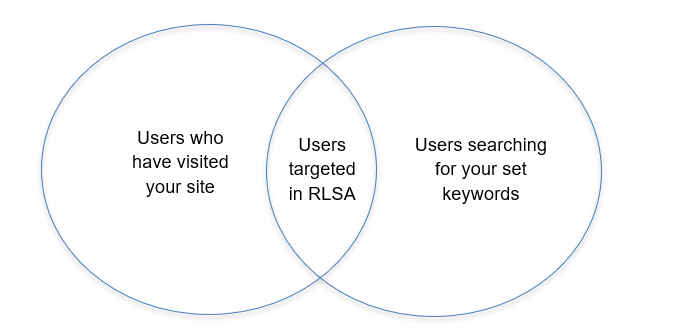The basics… RLSA stands for Remarketing Lists for Search Ads, and it has been a feature on Google Ads since 2013. Instead of targeting anybody searching for a given keyword on Google (or an affiliated search), RLSA specifically targets users who are searching for a keyword after having visited your site. Here, we’ll explore their results and how to best utilize them.
How it Works
The phrase “after having visited your site” probably brings up mental images of those stalker-ish visual ads for, say, adult diapers that follow you around the internet after you checked out Depends’ site that one time as a favor for your grandma. While those types of ads, known as display remarketing, keep your brand on a potential customer’s mind, they’ve also become a symbol of data-gathering and general internet creepiness. Luckily, the only thing these ads have in common with RLSA is that they both involve remarketing lists. Otherwise, they’re totally unrelated. RLSA is a more finesse combination of the two.
The foundation of RLSA begins when a user visits your site. Upon arrival, a cookie adds them to your remarketing list and, if you have at least 1,000 visitors in the past 30 days, you can use this information to activate an RLSA campaign. (You can also alter the time frame from which to draw users, or the pages they’ve visited and which to target.) Aside from the remarketing list, the other factor in RLSA campaigns is the search keywords. Whatever keywords you decide to bid on, the end result is that whenever someone on your remarketing list searches one of these keywords, your RLSA ad will be triggered. If there was a Venn diagram of “users who have visited your site” and “users searching for your set keywords,” the overlap of those circles would be the users targeted by your RLSA campaign.

For example, if your company rents boats in the San Juan Islands, you want to target users who are familiar with your product — i.e., have visited your site — and looking for a vacation. So, you create an RLSA campaign where ads are activated when those users Google “Pacific Northwest weekend” or “restaurants San Juan Islands.” As you probably notice, those are much more generic — or related — terms than one would typically bid on in a standard search campaign (where you’d have to go after specific search terms like “San Juan Islands vacations” or “sailboat rentals Washington”). That’s because, now that you’re only targeting a smaller pool who’s already aware of your product, you’re competing against far fewer other advertisers. Those broader search terms will yield higher ad placement for people who are already interested in your product or service.
Now, when users on your remarketing list search “Pacific Northwest weekend,” you can target them with an ad on your three-day sailboat rental special pricing. Similarly, if they search for “restaurants San Juan Islands,” you can show them an ad that directs to your promotional post, detailing the destinations of a boating trip that highlights places to eat on the way.
Which brings us to the question…
Should I use RLSA in an existing campaign, or create a separate, RLSA-only campaign?
There are two applications of RLSA in campaigns:
- Starting a new RLSA campaign, or
- Using RLSA in an existing Google Ads campaign.
Starting a New RLSA Campaign
Starting a separate, RLSA-exclusive campaign is the simplest option. You just need to mark the campaign setting to “targeting.” When choosing that setting, your campaign will work exactly like we’ve previously discussed: ads will be activated when both your keyword and remarketing lists are triggered — i.e. when someone who’s visited your site, then searches using one of the keywords on which you’ve bid.

Using RLSA in an Existing Google Ads Campaign
The other option is inserting RLSA into an existing campaign. Instead of setting your ad group to “targeting,” you would set your ad group to “observation.” The easiest way to think of this is like a conventional search keyword campaign and an RLSA-only campaign mashed together. Under this setting, Google will show ads to not only people on your remarketing list, but also to those who are searching your keywords and have never visited your site. However, where the RLSA comes in is that you can set a higher bid adjustment for users who have previously visited your site (and are on your remarketing list). Your ad bids will behave like normal for people searching your keywords, while putting your ads for users on your remarketing list at a higher bid.

Which is Better?
These two campaign types each have their pros and cons. The advantage of an RLSA-only separate campaign is that its conversion rate will be significantly higher, and thus each cent spent here will go much further to drive more leads. Another perk of keeping your RLSA campaign separate from your other campaigns is that you can use different strategies, like utilizing broader keyword lists, different bidding strategies, and writing more tailored, personalized ads since you know this audience a bit better than new, unfamiliar users. However, a disadvantage of placing RLSA in separate campaigns is that this method doesn’t work to increase your reach or audience pool, since your audience list would not include anyone who hasn’t visited your website yet.
Keeping your RLSA in the same campaign can help market to past users as well as increase reach to new visitors, which works to increase the size of your returning user audience pool. A caveat of this option is that this can be more expensive on a per-click basis since you’re targeting new and returning users. Since new site visitors would be included in this type of campaign, it’s more difficult to reduce keyword costs per click, which is traditionally a benefit of RLSA campaigns. After all, if your audience pool includes users who haven’t visited your site yet, there’s far more competition for higher ad placement. Plus, their lack of familiarity with your business means they aren’t as predisposed to pick you as people returning to your site again. So, in the end, these clicks will likely be more expensive as a result.
To Summarize
Keeping RLSA campaigns separate doesn’t increase reach, but they do usually drive more conversions, while layering RLSA audiences in existing search campaigns can create more volume but may drive fewer conversions. Which strategy you choose depends on the goals you have for the campaign.
The best of both worlds: Create a separate RLSA campaign while you optimize and increase the budgets in your other campaigns. That way, you can offer a more personalized experience to those who have been to your website and are more likely to convert, as well as grow your reach of your other site visitors.
Bid Strategies and How to Approach Them
When bidding on RLSA campaigns, the two main strategies are to either optimize bids for existing keywords or include bids for keywords you don’t normally bid on.
Optimizing Bids for Existing Keywords
This entails increasing your bids on campaign keywords that you’re already utilizing. Because RLSA ads are less blatant than display remarketing while also being more efficient than standard search keyword campaigns, it pays to pay.
If you apply too high a bid multiplier for display remarketing ads, their stalker-y nature can alienate potential users from being served too often, while if you do the same for generic search keyword campaigns, their inefficiency means you’re wasting money. With RLSA, using the same tactics will increase your presence significantly without annoying users — it’s a win-win!
Not only can you increase bids based on your RLSA audience, you can also increase bids based on which pages those users have visited on your site. For example, users who have visited specific product pages are further down the sales funnel than those who’ve only been to your homepage, while those who’ve placed items in their shopping cart before abandoning are even closer to making a purchase. Optimizing bids for users on the remarketing list for those specific pages means that each user that engages with your ads is more likely to convert.
Beyond strategic bidding, by segmenting audiences into different ad groups you can better tailor your advertising copy. Normal search campaigns rely on copy that realistically only applies to a small percentage of users viewing your ads. But targeting a remarketing list that is exclusively people who’ve visited a specific product page allows you to customize your ads accordingly. This means each user is more likely to relate to and follow through on your ad.
Choosing Keywords You Don’t Normally Bid On
This involves a bit more creativity. It’s easy to throw resources at a current “bid only” campaign but creating separate “targeting” campaigns with multiple keyword triggers allows you to uniquely target different customers who are arriving at your products via different lenses. If you sell, say; hockey gear, that means understanding and vying for hockey parents, novice adults, beer leaguers, varsity players, etc. — and adding different bids specifically for these classifications allows you a more nuanced, personalized approach.
So…Why Use RLSA?
If you read this and went “Gee, RLSA seems great and all, but they’re also a whole other campaign to set up, and that was a lot of words, and I’m feeling a bit overwhelmed,” then here’s four short and sweet reminders on the advantages:
- They reach customers already interested in your site, resulting in higher conversion rates.For many potential customers, there’s little you can do to make them go from “somebody who has never heard of your brand” to “somebody who’s buying your stuff,” and if you do convert it will take lots of time, energy, and money. By targeting people who’ve already shown interest in your site, you ensure those users seeing your ads are further down the purchase funnel and are more likely to convert from a site visitor into a customer.
- The set-up is simple. While digital ad campaigns can be overwhelming, RLSA is no more complicated than normal search campaigns, which means they’re not very complicated at all. Plus, you can easily alter a campaign — whether it’s bidding, copy, or targeting — as it progresses. Which brings us to…
- They help collect valuable customer data. RLSA helps you collect data on users’ tendencies, so you know how many people are at different points of the conversion process. By understanding the different pages frequented by visitors, you understand where you’re winning and losing conversions. Once you have that down, adapting with RLSA is easy with…
- Customizable targeted bids and ad messaging. With the ability to analyze customer data, you can personalize both bidding multipliers and advertising copy for different audience segments. For normal search ads, you’re using generic copy and hoping it sticks — copy that may not apply to most people seeing it. RLSA means you can target all your different users, whether that’s people who visited your site, viewed a product, abandoned their shopping cart, or already purchased from you. Instead of crossing your fingers on a shotgun approach search campaign, now you’re assured all these users are experiencing advertising that’s applicable to them.
While an optimal marketing strategy involves many mediums, those that focus on awareness and volume don’t mean much if none of those new users convert! RLSA is the closer that helps you optimize your advertising.




